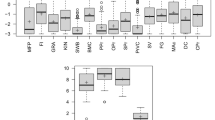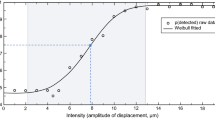Abstract
Sensory processing abnormalities in autism have largely been described by parent report. This study used a multi-method (parent-report and measurement), multi-trait (tactile sensitivity and attention) design to evaluate somatosensory processing in ASD. Results showed multiple significant within-method (e.g., parent report of different traits)/cross-trait (e.g., attention and tactile sensitivity) correlations, suggesting that parent-reported tactile sensory dysfunction and performance-based tactile sensitivity describe different behavioral phenomena. Additionally, both parent-reported tactile functioning and performance-based tactile sensitivity measures were significantly associated with measures of attention. Findings suggest that sensory (tactile) processing abnormalities in ASD are multifaceted, and may partially reflect a more global deficit in behavioral regulation (including attention). Challenges of relying solely on parent-report to describe sensory difficulties faced by children/families with ASD are also highlighted.
Similar content being viewed by others
References
Allen, G., & Courchesne, E. (2001). The problem with using eye-gaze to infer desire: A deficit of cue inference in children with autism spectrum disorder? Journal of Autism and Developmental Disorders, 37, 1761–1775.
American Psychiatric Association. (2013). Diagnostic and statistical manual of mental disorders (5th ed.). Washington, DC: American Psychiatric Publications.
Ames, C., & Fletcher-Watson, S. (2010). A review of methods in the study of attention in autism. Developmental Review, 30(10), 52–73.
Blankenburg, F., Taskin, B., Ruben, J., Moosmann, M., Ritter, P., Curio, G., et al. (2003). Imperceptible stimuli and sensory processing impediment. Science, 299, 1864.
Casey, B. J., Gordon, C. T., Mannheim, G. B., & Rumsey, J. M. (1993). Dysfunctional attention in autistic savants. Journal of Clinical and Experimental Neuropsychology, 15, 933–946.
Conners, C. K. (1997). Conners’ Parent Rating Scale-Revised (L). Tonawanda, NY: Multi-Health Systems.
Conners, C. K. (2008). Conners’ Parent Rating Scale-Third Edition. Tonawanda, NY: Multi-Health Systems.
Domínguez-Borràs, J., & Vuilleumier, P. (2013). Affective biases in attention and perception. In J. Armony & P. Vuilleumier (Eds.), The Cambridge handbook of human affective neuroscience. New York, NY: Cambridge University Press.
Fan, J., McCandliss, B. D., Sommer, T., Raz, M., & Posner, M. I. (2002). Testing the efficiency and independence of attentional networks. Journal of Cognitive Neuroscience, 14, 340–347.
Favorov, O. V., & Kursun, O. (2011). Neocortical layer 4 as a pluripotent function linearizer. Journal of Neurophysiology, 105, 1342–1360.
Gaetz, W., Bloy, L., Wang, D. J., Port, R. G., Blaskey, L., Levy, S. E., et al. (2014). GABA estimation in the brains of children on the autism spectrum: Measurement precision and regional cortical variation. Neuroimage, 86, 1–9.
Hilton, C. L., Harper, J. D., Kueker, R. H., Lang, A. R., Abbacchi, A. M., Todorov, A., et al. (2001). Sensory responsiveness as a predictor of social severity in children with high functioning autism spectrum disorders. Journal of Autism and Developmental Disorders. doi:10.1007/s10803-010-0944-8.
Holden, J. K., Nguyen, R. H., Francisco, E. M., Zhang, Z., Dennis, R. G., & Tommerdahl, M. (2012). A novel device for the study of somatosensory information processing. Journal of Neuroscience Methods, 204, 215–220.
Lord, C., Rutter, M., & Le Couteur, A. (1994). Autism Diagnostic Interview-Revised: A revised version of a diagnostic interview for caregivers of individuals with possible pervasive developmental disorders. Journal of Autism and Developmental Disorders, 24, 659–685.
Lord, C., Risi, S. Lambrecht, L., Cook, E. H. J., Leventhal, B. L., CiLavore, P. C., et al. (2000). The autism diagnostic observation schedule-generic: A standard measure of social and communication deficits associated with the spectrum of autism. Journal of Autism and Developmental Disorders, 30, 205–223. http://www.ncbi.nlm.nih.gov/pubmed/11055457.
Manly, T., Anderson, V., Nimmo-Smith, I., Turner, A., Watson, P., et al. (2001). The differential assessment of children’s attention: The Test of Everyday Attention for Children (TEA-Ch), normative sample and ADHD performance. Journal of Child Psychology and Psychiatry, 42, 1065–1081. http://www.ncbi.nlm.nih.gov/pubmed/11806689.
Manly, T., Robertson, I. H., Anderson, V., & Nimmo-Smith, I. (1999). The Test of Everyday Attention for Children. Bury St. Edmunds: Thames Valley Test Company Limited.
Parham, L. D., & Ecker, C. (2007). Sensory processing measure-home form. Los Angeles, CA: Western Psychological Services.
Puts, N. A., Edden, R. A., Evans, C. J., McGlone, F., & McGonigle, D. J. (2011). Regionally specific human GABA concentration correlates with tactile discrimination thresholds. Journal of Neuroscience, 31, 16556–16560.
Puts, N. A. J., Edden, R. A. E., Wodka, E. L., Mostofsky, S. H., & Tommerdahl, M. (2013). A vibrotactile behavioral battery for investigating somatosensory processing in children and adults. Journal of Neuroscience Methods, 218, 39–47.
Puts, N. A. J., Harris, A. D., Crocetti, D., Nettles, C., Singer, H., Tommerdahl, M., et al. (2015). Reduced GABAergic inhibition and abnormal sensory symptoms in children with Tourette syndrome. Journal of Neurophysiology, 114, 808–817. doi:10.1152/jn.00060.2015.
Puts, N. A. J., Wodka, E. L., Tommerdahl, M., Mostofsky, S. H., & Edden, R. A. E. (2014). Impaired tactile processing in children with autism spectrum disorder. Journal of Neurophysiology,. doi:10.1152/jn.00890.2013.
Reich, W., Welner, Z., & Herjanic, B. (1997). The Diagnostic Interview for Children and Adolescents-IV. North Tonawanda: Multi-Health Systems.
Rogers, S. J., & Ozonoff, S. (2005). Annotation: What do we know about sensory dysfunction in autism? A critical review of the empirical evidence. Journal of Child Psychology and Psychiatry, 26, 1255–1268. http://www.ncbi.nlm.nih.gov/pubmed/16313426.
Rojas, D. C., Singel, D., Steinmetz, S., Hepburn, S., & Brown, M. S. (2014). Decreased left perisylvian GABA concentration in children with autism and unaffected siblings. Neuroimage, 86, 28–34.
Simons, S. B., Tannan, V., Chiu, J., Favorov, O. V., Whitsel, B. L., et al. (2005). Amplitude-dependency of response of SI cortex to flutter stimulation. BMC Neuroscience, 21, 43–57. http://www.ncbi.nlm.nih.gov/pubmed/15969752.
Tannan, V., Simons, S., Dennis, R. G., & Tommerdahl, M. (2007). Effects of adaptation on the capacity to differentiate simultaneously delivered dual-site vibrotactile stimuli. Brain Research, 1186, 164–170.
Tomchek, S. D., & Dunn, W. (2007). Sensory processing in children with and without autism: A comparative study using the short sensory profile. American Journal of Occupational Therapy, 61, 190–200. http://www.ncbi.nlm.nih.gov/pubmed/17436841.
Tommerdahl, M. Tannan, V., Cascio, C. J., Baranek, G. T., & Whitsel, B. L. (2007). Vibrotactile adaptation fails to enhance spatial localization in adults with autism. Brain Research, 11, 116–123. http://www.ncbi.nlm.nih.gov/pubmed/17498672.
Tommerdahl, M., Favorov, O. V., & Whitsel, B. L. (2010). Dynamic representations of the somatosensory cortex. Neuroscience and Biobehavioral Reviews, 34. 160–170. http://www.ncbi.nlm.nih.gov/pubmed/15969752.
Wechsler, D. L. (2003). Wechsler Intelligence Scale for Children (4th ed.). San Antonio, TX: The Psychological Corporation.
Whitsel, B. L., Kelly, E. F., Quibrera, M., Tommerdahl, M., Li, Y., Favorov, O. V., et al. (2003). Time-dependence of SI RA neuron response to cutaneous flutter stimulation. Somatosensory Motor Research, 20, 45–69.
Wodka, E. L., Koriakin, T., Puts, N. A. J., Mahone, E. M., Edden, R. A. E., et al. (2014). Relationship between attention, hyperactivity/impulsivity, and sensory behavior in autism. Journal of the International Neuropsychological Society, S1(20), 203.
Zhang, Z., Francisco, E. M., Holden, J. K., Dennis, R. G., & Tommerdahl, M. (2011). Somatosensory information processing in the aging population. Frontiers of Aging Neuroscience, 3, 18.
Acknowledgments
This study was funded by The Organization for Autism Research (OAR) (ELW). Autism Speaks Translational Postdoctoral Fellowship (NAJP). NIH R01NS048527 and Autism Speaks (SHM). NIH R21 MH098228 (RAEE). Intellectual & Developmental Disabilities Research Centers (IDDRC) U54 079123. We would also like to acknowledge Taylor Koriakin for her efforts related to data collection and database management.
Author Contributions
ELW conceived of the study, participated in its design and coordination and drafted the manuscript; NAJP participated in the design, interpretation of the data, and revision of the manuscript; EMM participated in the design of the study and revision of the manuscript; RAEE participated in the design of the study and revision of the manuscript; MT participated in the design of the study and revision of the manuscript; SHM participated in the design of the study and revision of the manuscript, and provided participants through his ongoing studies. All authors read and approved the final manuscript.
Author information
Authors and Affiliations
Corresponding author
Ethics declarations
Conflict of interest
Mark Tommerdahl is co-inventor of the tactile stimulator used in the study and is co-founder of Cortical Metrics, which has a license from the University of North Carolina to distribute the device.
Ethical approval
All procedures performed in studies involving human participants were in accordance with the ethical standards of the institutional and/or national research committee and with the 1964 Helsinki declaration and its later amendments or comparable ethical standards.
Informed Consent
Informed consent was obtained from all individual participants included in the study.
Rights and permissions
About this article
Cite this article
Wodka, E.L., Puts, N.A.J., Mahone, E.M. et al. The Role of Attention in Somatosensory Processing: A Multi-trait, Multi-method Analysis. J Autism Dev Disord 46, 3232–3241 (2016). https://doi.org/10.1007/s10803-016-2866-6
Published:
Issue Date:
DOI: https://doi.org/10.1007/s10803-016-2866-6




